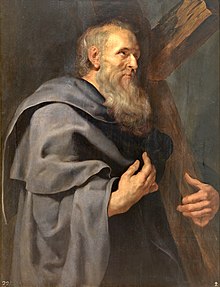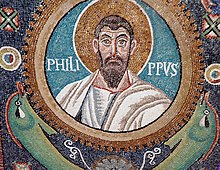
Back Sant Felipe apóstol AN فيلبس Arabic ܦܝܠܝܦܘܣ ܫܠܝܚܐ ARC فيلبس ARZ Həvari Filipp Azerbaijani Philippus (Apostl) BAR Філіп (апостал) Byelorussian Піліп (апостал) BE-X-OLD Филип (апостол) Bulgarian প্রেরিত ফিলিপ Bengali/Bangla
Philip the Apostle | |
|---|---|
 St. Philip, by Peter Paul Rubens, from his Twelve Apostles series (c. 1611), at the Museo del Prado, Madrid | |
| Apostle and Martyr | |
| Born | 1st century AD Bethsaida, Galilee, Roman Empire |
| Died | AD 80 Hierapolis, Asia, Roman Empire |
| Venerated in | All Christian denominations that venerate saints |
| Canonized | Pre-congregation |
| Major shrine | relics in Basilica Santi Apostoli, Rome |
| Feast | As Philip and James, Apostles, in the Roman Rite and in Protestant commemorations:
14 November and 30 June: Eastern Orthodox Church (Translation of relics on 30 June) 17 November: Armenian 18 November: Coptic |
| Attributes | Red Martyr, elderly, bearded man, holding a basket of loaves and a Tau cross |
| Patronage | Cape Verde; Hatters; Pastry chefs; San Felipe Pueblo; Uruguay |
Philip the Apostle (Greek: Φίλιππος; Aramaic: ܦܝܠܝܦܘܣ; Coptic: ⲫⲓⲗⲓⲡⲡⲟⲥ, Philippos) was one of the Twelve Apostles of Jesus according to the New Testament. Later Christian traditions describe Philip as the apostle who preached in Greece, Syria, and Asia-Minor.
In the Roman Rite, the feast day of Philip, along with that of James the Less, was traditionally observed on 1 May, the anniversary of the dedication of the church dedicated to them in Rome (now called the Church of the Twelve Apostles). In the short-lived calendar reform of 1960, it was transferred to 11 May, but since 1969 it has been assigned to 3 May. The Eastern Orthodox Church celebrates Philip's feast day on 14 November.
